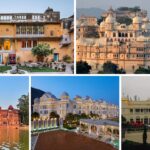Question: What makes purchasing handicrafts, fabrics, and fashion jewelry in Rajasthan such an unique experience?
Answer: Buying in Rajasthan isn’t practically acquiring attractive artifacts; it’s an immersive journey right into the state’s rich social tapestry. The handicrafts, fabrics, and jewelry here mirror centuries-old practices and craftsmanship passed down via generations. Each area of Rajasthan provides its very own distinct design, from Jaipur’s vivid pottery and complex marble carvings to Jodhpur’s well known lacquer job and Udaipur’s small paints soaked in Rajasthani heritage. Inquiry: Could you define some of the noteworthy textiles located in Rajasthan and where one might find them? Solution: Rajasthan is renowned for its vivid textiles that vividly mirror the desert landscapes and dynamic practices of the area. One of one of the most well-known is Bandhani, locally known for its tie-and-dye strategy. Jaipur and Jodhpur are hubs for Bandhani sarees and dupattas, showcasing complex styles and dynamic shades. In addition, Ajmer and Bhilwara are known for their vivid leheriya patterns, while Sanganer is celebrated for its elegant block-printed fabrics. Site visitors can discover busy markets like Jaipur’s Johari Exposition or Jodhpur’s Clock Tower Market to locate these timeless textiles.
Question: What makes Jaipur a paradise for precious jewelry enthusiasts?
Answer: Jaipur, known as the “Pink City,” is identified with exquisite precious jewelry workmanship. It supplies a treasure of options from conventional Kundan and Meenakari to the complex Thewa and amazing Polki jewelry. Kundan jewelry, with its refined gold setups and precious gems, is particularly searched for in Rajasthan. Meenakari fashion jewelry features detailed enamel work, while Thewa precious jewelry is renowned for its sophisticated glasswork embeded in gold. Jaisalmer and Jodhpur also master silver fashion jewelry decorated with semi-precious stones like blue-green, offering something distinct for every single precious jewelry lover.
Question: How do regional markets in Rajasthan add to the overall purchasing experience?
Answer: Rajasthan’s regional markets, bustling with energy and cultural appeal, play a vital role in the purchasing experience. These markets, or marts, are vivid hubs where site visitors can submerse themselves in the views, sounds, and aromas of Rajasthan. From the scent of spices to the mirrors of folk music, and the sight of skilled craftsmen at the office, each market uses a glance into the state’s rich imaginative heritage. Bargaining with vendors in the slim streets of Jaisalmer’s Sonaron Ka Baas or navigating the labyrinthine streets of Udaipur’s Hathi Pol Industry includes a genuine touch to the buying experience.
Question: Just how are efforts being made to preserve Rajasthan’s abundant creative practices?
Answer: Efforts to protect Rajasthan’s imaginative heritage are robust and continuous. Lots of artisans belong to household lineages devoted to details crafts, making certain that standard strategies are passed down through generations. Government campaigns and non-profit companies play an essential duty by providing training, workshops, and access to markets, thus advertising lasting practices and guarding cultural heritage for future generations.
Question: What would you claim is the essence of purchasing inventions, textiles, and precious jewelry in Rajasthan?
Answer: Purchasing in Rajasthan is more than just getting stunning artefacts; it’s about connecting with the state’s ingrained cultural heritage. Each piece of handicraft, fabric, or precious jewelry tells a story of ability, artistry, and social satisfaction. By sustaining regional artisans and their age-old customs, every purchase comes to be a purposeful payment to maintaining Rajasthan’s abundant artistic practices and guaranteeing their continuation for several years to come.



